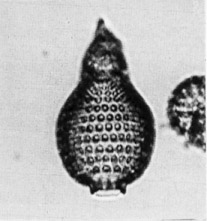 Dictyoprora
armadillo (Ehrenberg)
Dictyoprora
armadillo (Ehrenberg) Dictyoprora
armadillo (Ehrenberg)
Dictyoprora
armadillo (Ehrenberg)Eucyrtidium armadillo Ehrenberg, 1873, p.225; 1875, p.70, pl.9, fig.10
Theocampe armadillo (Ehrenberg) group, Riedel and Sanfilippo, 1971, p.1601, pl.3E, figs.3-5 (partim.)
Dictyoprora armadillo (Ehrenberg), Nigrini, 1977, p.250, pl.4, fig.4
Shell rather smooth, thick-walled, cephalis small, subspherical with few large pores and well-developed, three-bladed apical horn. Vertical tube short, cylindrical, upwardly directed. Thorax relatively small, inflated with large circular pores, irregularly arranged. Abdomen large, bulbous with 12 to 15 closely spaced transverse rows of circular pores, downwardly directed arches framing distal pores. Shell narrows sharply to well-developed, poreless peristome with smooth, even termination; transverse section circular (Nigrini, 1977).
Based on four specimens. Total length (excluding apical horn) 177-225 µm; maximum breadth 95-105 µm (Nigrini, 1977).
D. armadillo is distinguished from other artostrobiids by having a three-bladed horn and a large, bulbous abdomen with closely spaced transverse rows of circular pores, that are framed by downwardly directed arches (Sanfilippo, unpubl. data).
It is rather constant during its short range.
This species is found in low-latitude sediment samples from all oceans. Its morphotypic first appearance lies within the Podocyrtis goetheana Zone and its morphotypic last appearance is at the top of the Cryptocarpium ornatum Zone.